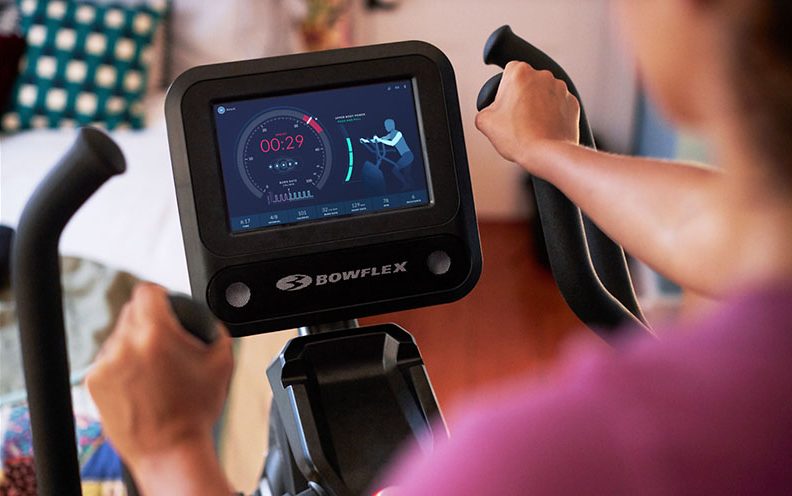At its Investor Day event, Nautilus Inc. laid a long-term strategic plan to nearly double sales by 2026 as it looks to take advantage of the dramatic shift toward at-home fitness. Shares of Nautilus, however, remain under pressure due to a weak outlook for margins.
On the day of the event, March 18, shares fell $2.26 to $18.68 and continued falling in the days ahead. On Thursday, March 26, shares closed at $15.49.
The stock has been on a whirlwind ride due to investor enthusiasm over the pandemic-driven acceleration of the at-home fitness trend accelerated by the pandemic. Shares were trading at only $1.75 at the start of 2020.
The At-Home Fitness Opportunity
At the event, Jim Barr, Nautilus’ CEO, detailed how the pandemic accelerated many trends already in motion as consumers turned to home fitness after being unable to go to their gym. Nautilus believes this has likely led to long-term structural changes in the fitness industry that favor at-home fitness.
“Had the pandemic lasted just a few weeks, this might have been temporary with some sales likely pulled forward from later in the year,” said Barr. “However, as weeks became months with a view that it might last a year or more, habits and attitudes toward the gym began to change in profound ways. The home became the center of our lives, our places of business, where we schooled our children, our entertainment venue, and the place where we worked out. It may have been forced upon us, but we discovered, or rediscovered, the convenience of working out at home.”
Many individuals also discovered connected fitness for the first time and how the technology could bring many aspects of the gym to their home, including trainers, classes, connectedness, community, and variety.
Nautilus last summer began polling thousands of gym members starting regularly and the results have been “remarkably unchanged for eight months” through gym re-openings, vaccination announcements and vaccination availability. Said Barr, “The results paint a persuasive picture of not only incredibly rapid growth but that the industry has undergone long term to permanent change.”
The surveys show that about 25 percent of former gym goers indicated they would never go back to the gym. About half are uncomfortable about returning to the gym. Barr said, “Many of those who will return to the gym when things are safe said they would balance the gym and home differently in a permanent way, similar to how they expect to balance working from home and going into their places of business. No longer one or the other, but a blend of both.”
Barr noted that trends might shift back significantly in a post-pandemic future; however, he also said that if only 10 percent of former gym goers do not return to the gym and embrace home fitness, this would suggest that $4.9 billion of the gym membership market would move to support at-home fitness growth. That’s more than double the $3.6 billion in addressable opportunities Nautilus saw in the home fitness market before the pandemic’s arrival.
Another likely tailwind supporting at-home fitness growth is the work-from-home trend. Daily commutes have long been a critical driver in gym visits.
Barr said Nautilus is well-positioned to capitalize on the at-home fitness opportunity through its well-known brands, strong product portfolio, broad omnichannel distribution, and recent amplified emphasis on connected fitness. Over the short term, the company plans to target former gym-goers’ evolving needs through marketing, new journey features, and new product launches.
“No one can predict exactly how this will play out over the next few years,” said Barr. “It seems likely that not all of this market expansion is repeatable each year. Thus, it is probable that the market growth will not be linear and, at some point, the market size likely regulates from its highest point, but not down to anywhere near pre-pandemic levels. With the size of the prize and as the number three player in the fragmented industry, we will need to remain agile to react to capitalize on this opportunity fully.”

Five Pillars Of North Star Strategy
Nautilus’ team highlighted the five key strategic pillars of North Star expected to drive its path to digital transformation:
- Adopt A Consumer First Mindset: Nautilus’ product development approach has been restructured to gather consumer input at the beginning of the process, with marketing messages now being tested early in the development cycle to ensure they’re emotionally connected with consumers. Category management is emphasized over traditional product management. Nautilus is exiting the value segment to focus on mid-tier and premium products with a brand portfolio emphasis on Bowflex, Schwinn and its JRNY digital-fitness platform.
- Scale A Differentiated Digital Offering: In the past quarter, Nautilus has seen a four-times increase in JRNY members since launching the VeloCore bike and connected treadmills. In addition, hundreds of thousands of BYOD products linked to JRNY shipped in the last few years see strong demand. Other opportunities for JRNY’s growth include non-connected products in the field, international and strategic partnerships, such as third-party wearables, SmartTVs, and commercial gym operators.
- Focus Investments On Core Businesses: The focus will be on “making fewer, bigger and bolder bets” around its three core brands: Bowflex, Schwinn and JRNY. The Octane Fitness brand was sold last October, the Universal brand has been discontinued, and the company is evaluating the next steps for the Nautilus brand. Officials told analysts the Nautilus and Universal brands account for about $25 million to $30 million in annual sales. The company plans to have “a more focused and deliberate portfolio, where each product within each brand will have an identified reason for being.” International won’t be targeted as a major growth driver until after 2026.
- Evolve Supply Chain To Be A Strategic Advantage: In 2020, Nautilus worked to increase its capacity up to five times, and it continues to take steps to meet continued elevated demand. Longer-term, geographic diversity will be a focus to reduce its risk and transport times.
- Build Organizational Capabilities To Win: Existing skills will be leveraged in new ways, and new capabilities attained to support its digital transformation.
Five-Year Plan Growth Targets
Nautilus also provided targets under its five-year plan through fiscal 2026.
The plan calls for $1 billion in total revenue by 2026 from $604 million to $623 million predicted for the 12 months ending March 2021, expanding at a CAGR of 10 percent. The growth is expected to be driven by an incremental $177 million to $196 million of fitness equipment sales, expanding at a 5 percent to 6 percent CAGR. Approximately $200 million in revenue is expected to come from JRNY digital subscriptions, with the subscriber base expected to expand from a targeted 250,000 subscribers in fiscal 2022 to 2 million by fiscal 2026. At least 20 percent of total revenue is expected to come from digital subscriptions in 2026.
Nautilus is targeting “at least” 10 percent annual operating margins with the benefit of a “more reliable” revenue stream.
Barr said, “Today, we are not a one product-driven company but a much more diversified revenue platform with a rapidly growing digital component enabling all consumers to rely on Nautilus for their entire fitness journey. We operate in a very dynamic industry with a profoundly expanded opportunity that includes changing consumer habits, technology preferences, and connectedness, providing us a way to help our consumers on all aspects of their journey. The North Star strategy will ensure the “new” Nautilus will properly leverage our leading brands, products, innovation, distribution and digital assets to build a healthier world, one person at a time.”
Wall Street’s Take
The stocks’ weakness has been attributed to the operating margin outlook.
»At William Blair, Sharon Zackfia, who maintained her “Outperform” rating on Nautilus, said that while her team understands the market’s reaction, the target of “at least” 10 percent should be seen as a baseline reference point to measure the transformation of the company and “not an ultimate end goal.” Zackfia sees potential to reach sustainable double-digit operating margins earlier. Zackfia added, “We also continue to believe Nautilus is well-positioned to capitalize on continued strength in at-home fitness, with the company’s pivot to connected fitness likely to unlock greater profitability as JRNY scales. Risks include the sustainability of pandemic-fueled sales, the early stage of the company’s transition to connected fitness, and the ability to meet demand.”
»At Truist Securities, Michael Swartz maintained its “Buy” rating at a $30 price target following the investor day event. Swartz wrote in a note, “We came away with more conviction in the L-T optimization/digital transformation story and believe the negative stock reaction (to, in our view, conservative long-range financial targets) is overblown. NLS remains a compelling small-cap growth idea with ample upside to earnings/valuation over the coming 12-24 months.”
»At Lake Street Capital Markets, Mark Smith maintained his “Buy” rating at a price target of $40. Smith wrote, “We think there will be headwinds and bumps along the way, such as the current port and logistics issues, but the strategy is sound for building a $1B revenue business with strong and sustainable margin. In our view, the most important takeaways from the investor day are the focus on customer satisfaction in giving them products they want, where and how they want it, and products that will evolve with and be personalized with the consumer.”
»At Roth Capital, George Kelly lowered his price target on Nautilus to $26 from $29 but kept a “Buy” rating on the shares. While Kelly credited Nautilus’ management for working to build a more stable business and financial model and noted progress in its transformation, the long-term guidance was described as “underwhelming.” Kelly believes the stock will likely remain “range-bound” in the near-term.
»At Craig-Hallum, Steven Dyer likewise lowered his price target to $25 from $30 and kept his “Buy” rating. In a note, Dyer said he believes Nautilus’ new strategic roadmap was a necessary one, but he also believes the move from purely hardware to a recurring subscription model will not be easy or inexpensive. Other risks include a lack of visibility to margins over the medium term and the degree to which demand for at-home fitness will continue post-COVID-19.
Photos courtesy Nautilus
















